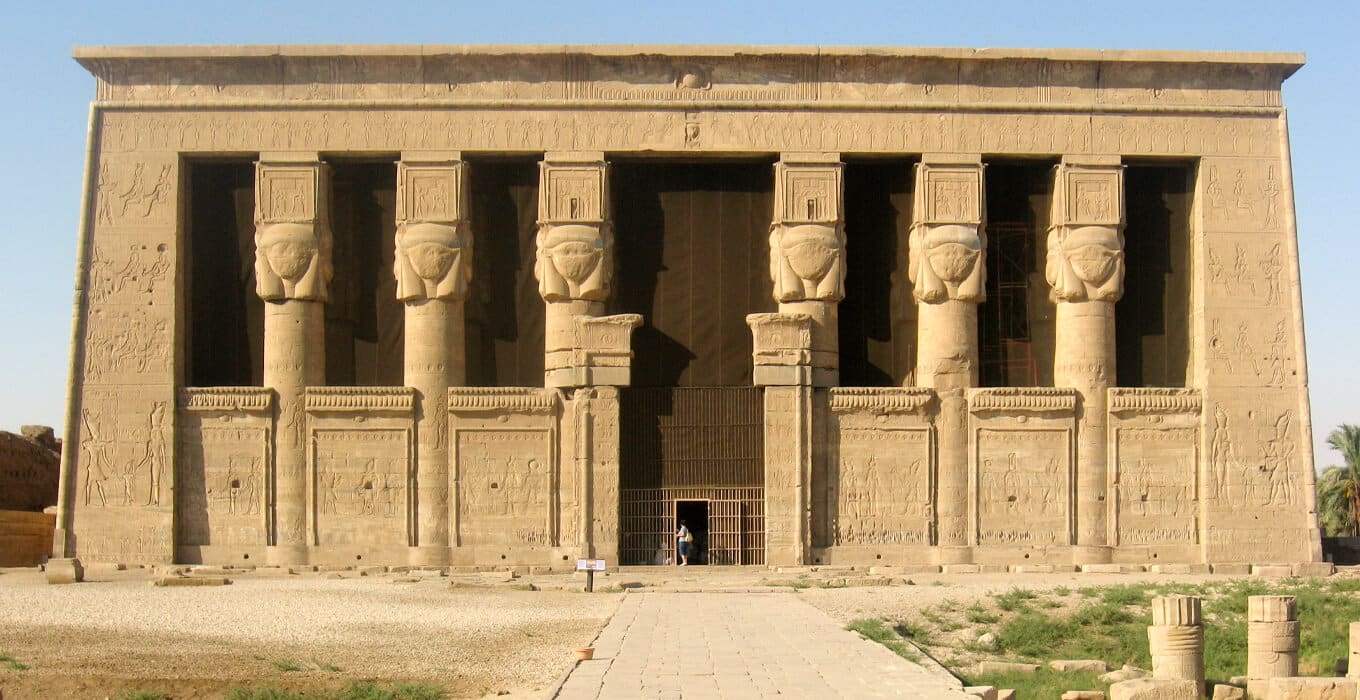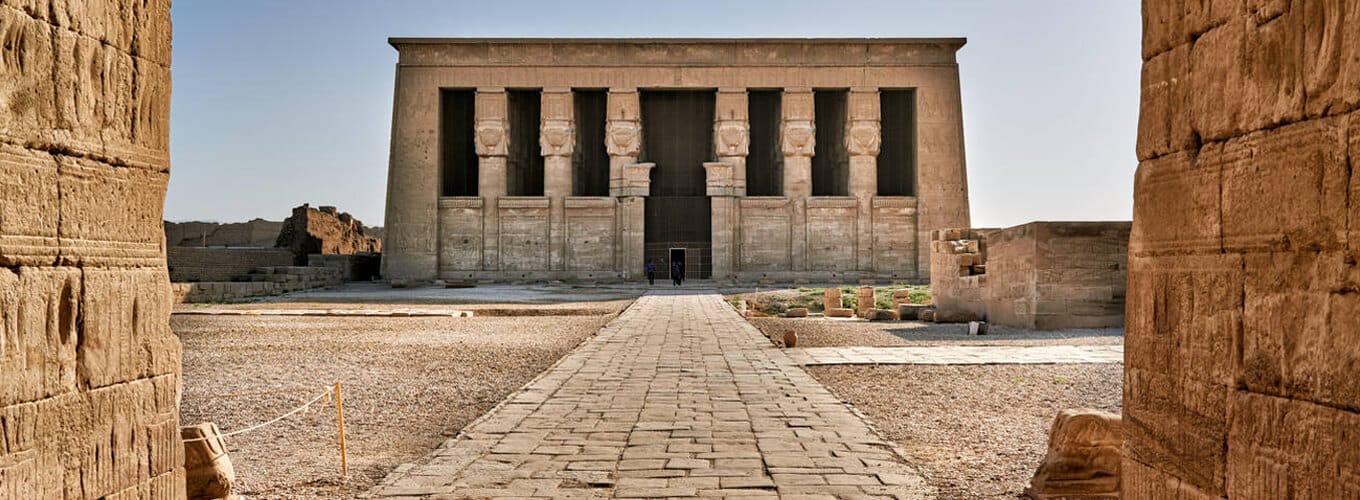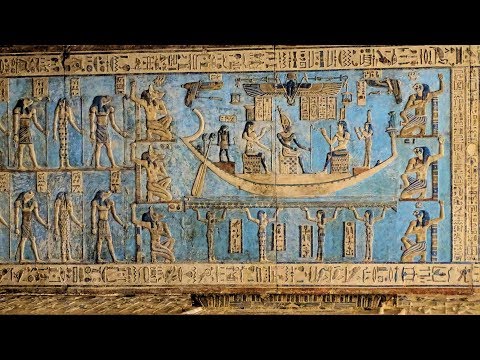Just an hour and a half from Luxor, the Temple of Dendera shows off ancient Egyptian achievements. It’s a place where history and mythology come alive. Temple of Dendera colors and carvings are still bright and detailed today.
This Ptolemaic-era temple is dedicated to the goddess Hathor. It’s one of the best-preserved ancient Egyptian sites. For just $3 USD, you can enter this amazing place. Getting there from Luxor costs about $30 USD by taxi, making it easy and cheap to visit.
Key Takeaways
- The Temple of Dendera is just an hour and a half from Luxor. It’s a great day trip that won’t cost much.
- The temple shows off beautiful ancient Egyptian architecture. You’ll see the famous Dendera Zodiac and the Hathor Temple, known for their colors and carvings.
- Here, you can learn about Egyptian mythology and the goddess Hathor. Don’t miss the Dendera Sound and Light Show.
- It’s a less crowded spot compared to other Luxor temples like Edfu and Kom Ombo, which are farther away.
- The Temple of Dendera is perfect for history lovers and anyone wanting to explore ancient Egypt’s culture.
The Majestic Temple of Hathor at Dendera
The Hathor Temple is in the Dendera Temple Complex. It shows off ancient Egypt’s amazing architecture. Built during the Greco-Roman period, it has amazed people for centuries. It gives us a peek into the rich culture of the Nile Valley.
Ancient Egyptian Architecture Marvel
The Hathor Temple is for the goddess of love and joy. It has a stunning hall with 24 big columns, each with Hathor’s head. The blue ceiling shows stars and planets, making it a place of deep respect and wonder.

Dendera Temple Complex
The Dendera Temple Complex includes the Hathor Temple. It’s surrounded by a big mud brick wall, adding to its ancient beauty. Inside, you can see many reliefs and carvings of gods like Isis, Osiris, and Horus.
The complex is huge, covering 40,000 square meters. It started in the Old Kingdom around 2575-2150 BC. It was rebuilt and expanded over time, especially in the Ptolemaic and Roman eras.
“The Hathor Temple is a true masterpiece of ancient Egyptian architecture, showcasing the ingenuity and artistry of the Nile Valley’s builders and craftsmen.”
Dendera’s Intriguing Mysteries
The Dendera Temple Complex in Egypt is full of mysteries that have caught the attention of many. The Dendera Zodiac and the Dendera Light Bulb Theory are two of these mysteries. They have made scholars and visitors very curious.
The Dendera Zodiac
The Dendera Zodiac is on the ceiling of a chapel in the Hathor Temple. It shows the constellations and the signs of the Zodiac. Many people have tried to figure out what it means and how it relates to ancient Egyptian myths and stars.
Dendera Light Bulb Theory
There’s also the Dendera Light Bulb Theory. It says some carvings in the temple show an old kind of electric lighting. This idea makes us rethink what ancient Egyptians knew about technology. It has sparked a lot of talk among Egyptian Mythology fans.
“The Dendera Temple Complex is a treasure trove of mysteries, each one more captivating than the last. The Dendera Zodiac and the Dendera Light Bulb Theory are just two examples of the intriguing puzzles that this ancient site has to offer.”
Visitors to the Dendera Temple get to dive into its deep history and the questions it raises. This amazing place is only 37 miles north of Luxor, Egypt.
Temple of Dendera Near to Luxor: A Journey Through Time
The Temple of Dendera is near Luxor and takes you on a journey through ancient Egypt’s history. It’s a Ptolemaic temple with Roman additions. It shows the lasting culture and architecture of this amazing civilization.
The temple was built over many dynasties. It’s a wonder of Ancient Egyptian Architecture. You can see detailed reliefs and carvings. They show the religious and cultural life of the area. The temple changed from the Ptolemaic to the Roman era, showing the mix of cultures.
The Dendera Zodiac is a key feature of the temple. It’s a beautiful picture of the stars on the ceiling. Scholars and visitors find it fascinating, showing the ancient Egyptians’ knowledge of the stars.
The Dendera Light Bulb theory is another interesting part of the temple. It says the ancient Egyptians might have known about electricity. This idea makes the temple even more mysterious.
Visiting the Temple of Dendera lets you feel the grandeur of Luxor Temples. The temple is well kept, showing its importance. It takes you back in time to connect with ancient Egyptian life.
| Key Fact | Statistic |
| Day Trip Duration | Approximately 10 hours |
| Driving Distance (Luxor to Dendera and Abydos) | 360 km (6 hours) |
| Time Spent at Each Temple | Around 2 hours |
| Driving Distance (Luxor to Abydos) | 170 km (3 hours) |
| Abydos Entrance Fees | 240 EGP per adult, 120 EGP per student |
| Driving Distance (Abydos to Dendera) | 105 km (1.5 hours) |
| Dendera Entrance Fees | 240 EGP per adult, 120 EGP per student, 50 EGP for panorama, 100 EGP for catacombs |
The Temple of Dendera near Luxor shows the lasting impact of ancient Egyptian culture. It has Ptolemaic Temple architecture, secrets, and amazing sights. This site takes visitors on a deep dive into the past, highlighting the achievements of this ancient society.
Uncovering Egyptian Mythology at Dendera
The Temple of Dendera shows the lasting impact of Egyptian Mythology. It honors the Goddess Hathor. It’s near Luxor, about 60 kilometers north. The Dendera Temple Complex is a place that takes you back in time. It shows the deep beliefs and symbols of ancient Egypt.
The Goddess Hathor
The Dendera Temple Complex has a special spot for the Temple of Hathor. It’s for the Goddess Hathor, who was all about joy, music, and love. She was a big deal in ancient Egypt. Her place at the Dendera Temple shows how important it was for worship and culture.
- The Hathor Temple has a Birth House, Sanctuary, and a Hypostyle Hall with 24 columns of Hathor heads.
- The Mammisi, or Birth House, celebrates the divine child of Hathor and Horus.
- The Dendera Zodiac Ceiling in the Hypostyle Hall shows the stars and planets seen by ancient Egyptians. It shows the temple’s link to the heavens.
Visiting the Dendera Temple Complex is a journey into Egyptian Mythology. It’s a place that will amaze and teach you a lot.

Experiencing the Dendera Sound and Light Show
Visitors to the Dendera Temple Complex will find a truly magical experience. The Dendera Sound and Light Show brings history and myths to life. It uses lighting effects, narration, and the temple’s architecture.
As the sun sets, the Hathor Temple lights up. It casts a warm glow over the complex. The show takes you back in time to ancient Egypt. It’s more than just a show; it’s a journey into the culture of this site.
| Tour Details | Ticket Prices | Booking Inclusions |
| Duration: 6 hours | Starts at $35 |
|
Ticket Options:
|
Taxes and fees calculated at checkout |
|
| Cancellation Policy: 24-hour notice for full refund |
The Dendera Sound and Light Show is a top attraction near Luxor. It’s a unique way to experience Ancient Egyptian Architecture and mythology.
Planning Your Visit to the Dendera Temple
Visiting the Temple of Dendera near Luxor is a must for anyone in Egypt. This ancient temple is dedicated to the goddess Hathor. It shows off Egypt’s rich culture. Planning your trip is easy, with the temple open every day and low admission fees.
Opening Hours and Admission Fees
The Temple of Dendera welcomes visitors from 7:00 AM to 5:00 PM every day. Here are the admission fees:
- Adults: $12 USD (or equivalent in Egyptian Pounds, Euros, or British Pounds)
- Students (with valid ID): $6 USD
- Children under 6 years old: Free
Visitors can see the temple’s ancient architecture, detailed carvings, and the famous Dendera Zodiac at their own speed.
Getting to Dendera from Luxor
The Temple of Dendera is about 77 km (48 miles) north of Luxor. The drive takes around 1 hour and 40 minutes. Many tour companies offer day trips from Luxor to the temple, with transportation and a guide. Or, you can take a private car or a taxi there.
| Distance from Luxor | Travel Time | Transportation Options |
| 77 km (48 miles) | 1 hour 40 minutes |
|
Whether you join a guided tour or go on your own, the Temple of Dendera near Luxor is a memorable experience for all.
Nearby Attractions and Day Trips
The Temple of Dendera is a great place to visit, but there’s more to see nearby. A short drive takes you to the Abydos Temple Complex. It’s home to the famous temple of Seti I.
Abydos is a key archaeological site in Egypt. It has the “Abydos King List” and the Osireion temple. Tours often combine visits to Dendera and Abydos. This lets visitors see the history and stunning architecture of these sites.
Exploring the Temples of Abydos
Getting to Abydos from Luxor takes about 3 hours by car. The distance is around 170 km (105.6 miles). At Abydos, you’ll spend about 2 hours seeing the Temple of Seti I, the Osireion, and the Abydos King List.
Then, it’s another 1.5 hours to the Dendera Temples, which is 105 km (65.2 miles away. The full day trip covers both temples and takes about 10 hours.
It’s best to visit these sites with a guide because the roads can be rough. The cost to enter is 240 EGP for adults and 120 EGP for students at both temples. You can also pay extra for the panorama and catacombs at Dendera.
If you’re short on time, there’s a 5-hour trip to the Dendera Temples. This includes about 3 hours of driving.
Temple of Dendera Near to Luxor: More Than Just a Historic Site
The Temple of Dendera is near Luxor in Egypt. It’s more than a look into ancient history. This temple is a wonder of ancient Egyptian architecture. It shows the amazing skills of the Ptolemaic and Roman times.
This temple is also tied to ancient Egyptian myths and beliefs. It was a place where the goddess Hathor was worshipped. The temple has many mysteries and legends that still interest people today.
Visiting the Dendera Temple is an unforgettable experience. You’ll see beautiful architecture and learn about Egyptian myths. It’s a place that will leave a strong impression on you. Walking through the temple, you’ll feel like you’ve stepped back in time.
Read our related articles:


